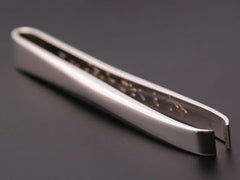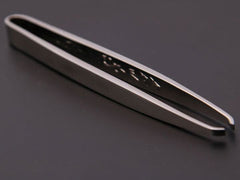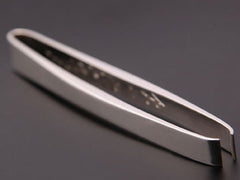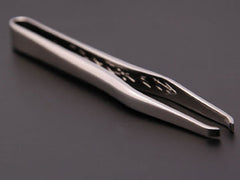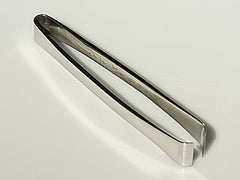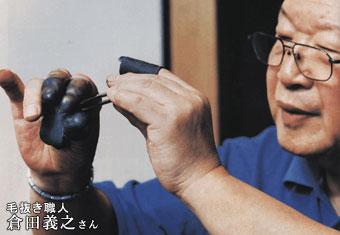
Tweezers that "reliably capture and gently remove even fine hairs 5/1000 of a millimeter in size"
Experience the craftsmanship of Edo-style hand-made tweezers, recipients of the Traditional Craftsmanship Award, along with a comfortable feel. These products are designed to last for long periods without tiring you out, so why not try them and release the stress of using tweezers? Their sturdy and carefully crafted construction is sure to last you a lifetime.
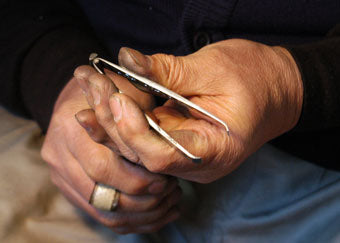
What are "Edo Handmade Tweezers"?
Based on the bivalve shell tweezers used by commoners since the Muromachi period, "Edo Honteuchi Tweezers" have been revived today using Edo Honteuchi techniques. Kurata Yoshiyuki, the third-generation owner of Kurata Seisakusho, founded in 1875, is the only craftsman in Japan who continues to carry on this traditional Edo-period manufacturing method. Each tweezers is handcrafted, hammering 3mm-thick 18-8 stainless steel plates over 500 times. Their outstanding craftsmanship surpasses the limits of conventional machine presses, and in 1997, they received the Arakawa Ward Traditional Craftsmanship Merit Award for their outstanding craftsmanship. "Edo Honteuchi Tweezers" are now widely used by professionals as beauty and ophthalmological instruments.
Three points to distinguish good tweezers
1.When you close the blades and hold them up to the light, no light enters between the blades.
2.When you look at the tweezers from the side, the blades fit together perfectly.
3.There is a spring that helps to grip the hair.
If even one of these three points is missing, it can be very painful to pluck the hair, or the hair may break off in the middle. Edo Handmade Tweezers are a product that meets all three of these points. If you have a pair, you can use them for a long time.
How to use
The tweezers' blades are perfectly aligned. When you place the hair you want to pluck on the tweezers, the blades will naturally grip the hair, allowing you to pull it out smoothly without applying excessive force.
Care
The jaws on tweezers are very delicate. Even small amounts of skin oil or makeup can create gaps and prevent tweezers from being removed.
For daily care, we recommend lightly wiping the jaws with a soft cotton cloth after use. The jaws may also become misaligned if the tweezers are knocked against other objects in a drawer or dropped, so we recommend storing them in the box provided or wrapped in a cloth.
How Edo Handmade Tweezers are made
The skilled master, Kurata, can only make around 10 tweezers a day. He adjusts the thickness with his fingers and eyes, and goes through over 30 steps to create a piece known as an "Edo Handmade Tweezers." His skilled handwork is a "craftsmanship" that has been passed down since the Edo period.
(1) Material selection, hammering, core removal, and seasoning
First, both ends are hammered in with a hammer. Next, the central part that will become the spring is carefully hammered while turning the piece over. This is the process of "removing the core" from the material, and is a technique that requires skilled control of the force. The piece is then hammered again to smooth the surface.
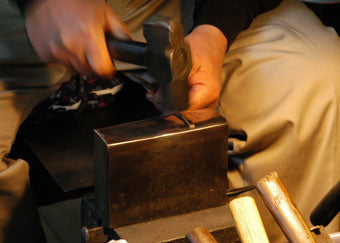
(2) Die cutting, filing, deburring, and polishing
The parts that have stretched horizontally after being hammered are then pressed out. The cut-out surface is filed, and then filed diagonally. This process carefully removes any rough areas known as "burrs," leaving the piece smooth to the touch. Three types of buffs (sand, linen, and cloth) are used to polish the piece.
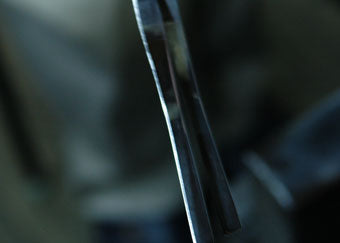
(3) Striking, inscription, striking, sharpening, tip bending, center bending
He moves to a homemade workbench and corrects any slight bends with a "sori-uchi" (beating) technique. He then carves the name "Kurata Yoshiyuki," a registered trademark. He beats the blade again and sharpens the blade (the part that holds the hair). He bends the head (tip) into the shape of tweezers and adjusts it. Finally, he bends the central part, which has been cored, and beats it again to set the shape.
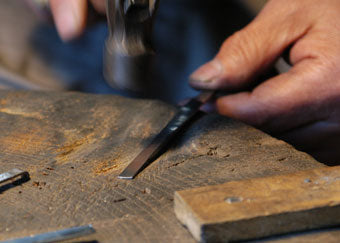
(4) Polishing, filing, tooth alignment, grinding, and finishing
Four types of buffs (sand, linen, thread, and cloth) are used to smooth the surface. Next, three types of files (coarse, medium, and fine) are used to file the teeth that grip the object. After checking the shape and spring elasticity, the teeth are fitted together perfectly. Finally, a grinding stone is placed in the opening of the tooth tip for the final finish.
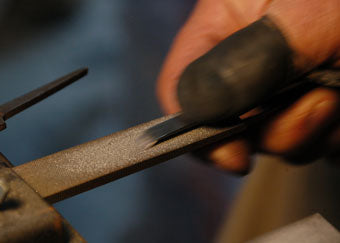
How to choose tweezers
Edo-style handmade tweezers have come in several shapes since ancient times. Please refer to the following three points to help you decide which one to choose.
(1) Shape
Our shop carries five types of Edo-style handmade tweezers: "Iroha," "Komaru," "Gourd," "For eyebrows," and "For inverted eyelashes."
In addition to the "eyebrows" and "inverted eyelashes" tweezers, which have clearly defined uses, we also have "Iroha" tweezers that can be used for a variety of purposes, "Komaru" tweezers that are comfortable even when used for long periods of time, and "Gourd" tweezers, which feature beautiful lines and can pluck fine hairs without exerting force.
Each shape is rich in traditional charm, so please choose the one that suits your taste.
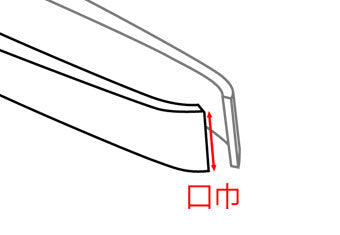
(2) Muzzle
The width of the opening varies depending on the shape.
The "Inverted Eyelash" and "Gourd" have a 2mm opening, the "Eyebrow" has a 3mm opening, and the "Iroha" and "Komaru" have a 6mm opening.
A narrow opening is recommended for plucking hairs in small areas such as eyelashes and eyebrows, while a wider opening like the "Iroha" is recommended for plucking hairs in relatively large areas such as beards and armpit hair.
(3) Materials
Items with "Pure Silver" in the product name are made from pure silver. Silver is said to have antibacterial properties.
Items without a material designation are made from stainless steel. They are characterized by their reasonable price compared to pure silver.
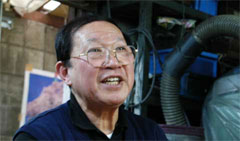
A word from the craftsman
"It would be nice to hear someone say, 'It's been used by three generations of my family,'" he said. "If you consider that it can be used for a long time, or even for a lifetime, I don't think it's a high price at all."
